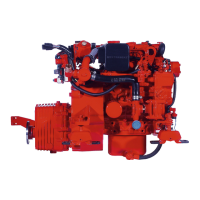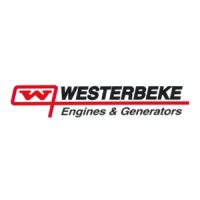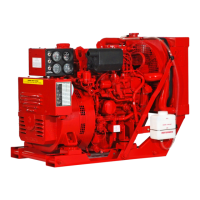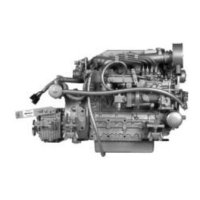LAY-UP
&
RECOMMISSIONING
Starter
Motor
-,
Lubrication
and
cleaaing of
the
starter drive
pinion
is
advisable,
if
access
to
the
starter
permits
its
easy
removal.
Make
sure
the
battery
connections
are
shut off before attempting
to
remove
the
starter.
Take
care
in
properly replacing aay electrical
connections
removed
from
the
starter.
Cylinder
Lubrication
[Diesel]
If
you
anticipate a
long
lay-up period
(12
months
or
more)
WESTERBEKE
recommends
you
coat the engine
cylinders
with
SAE
#40
oil.
To
do
this, either remove
the
glow
plug
for
each
cylinder
or
the
fuel
injector,
which ever is
easiest.
Squirt
a
good
quantity
of
oil
into
each
cylinder.
Then rotate
the
engine
crankshaft
by
hand
slowly
two
revolutions. Re-install the
glow
plugs
or
injectors.
Make
sure you
have
available aay
sealing
washers
that
may
be
needed
for
the
injectors
return
line
..
Intake
Manifold
[Gasoline]
Clean
the
filter
screen
in
the
flame
arrester,
aad place a
clean
cloth
lightly
soaked
in
lube
oil
around
the
flame
arrester
to
block
any
opening.
Also
place aa oil-soaked cloth
in
the
through-hull exhaust
port,
Make a
note
to remove
cloths
prior
to
start-up!
Cylinder
Lubrication
[Gasoline]
With
the
engine
running,
spray
the
fogging
oil
into
the
open
intake, stalling
the
engine.
This will
lubricate,
the
valves
aad
cylinders
..
NDTE:
At
spring commissioning,
remove
and clean
the
spark
plugs and
rotate
the
engine
by
hand
two
complete
revolutions.
Re-install the
spar.k
plugs,
tighten properly and reconnect
the
high
tension
leads fully onto each spark plug.
Batteries
If
batteries
are
to
be
left
on board during the lay-up
period,
make
sure
that
they
are
fully
charged,
aad will remain
that
way,
to
prevent them
from
freezing.
If
there
is
any
doubt that
the
batteries will
not
remain
fully
charged,
or that
they
will
be
subjected
to
severe
environmental
conditions,
remove
the
batteries
and
store
them
in
a
warmer,
more
compatible
environment.
A
WARNING:
Lead
acid
batteries
emit
hydrogen,
a
highly·explosive
gas,
which
can
be
ignited
by
electrical
arcing
or
a
lighted
cigarette,
cigar,
or
pipe.
Do
not
smoke
or
allow
an
open
flame
near
the
battery
being
serviced.
Shut
off
all
electrical
equipment
in
the
vicinity
to
prevent
electrical
arcing
during
servicing.
Transmission
[Propulsion
Engine]
Check
or
change
the
fluid
in
the
transmission
as
required
Wipe
off
grime
aad
grease
aad touch
up
any
unpainted
areas.
Protect
the
coupling
and
the
output
flange
with
an
anti-corrosion
coating.
Check
that
the
transmission vent
is
open.
For
Spare
Parts
Lay-up
time
provides
a
good
opportunity
to
inspect your
Westerbeke
engine
to
see if external
items
such
as drive belts
or
coolant hoses
need
replacement.
Check
your
basic
spares
kit
and
order items
not
on
hand,
or
replace
those
items used
during
the
lay-up,
such
as
filters
and
zinc
anodes.
Refer
to
the
SPARE
PARTS
section of
this
manual.
Recommissioning
The
recommissioning of
your
Westerbeke
engine
after
a
seasonal
lay-up generally
follows
the
same
procedures
as
those described in
the
PREPARATIONS
FOR
STARTING sec-
tion regarding preparation
for
starting
aad
normal
starts,
However,
some
of
the
lay-up
procedures
will
need to
be
counteracted before
starting
the
engine.
1.
Remove
the
oil-soaked
cloths
from
the intake manifold.
2.
Remove
the
raw
water
pump
cover
and
gasket
and
discard
the
old
gasket.
Install
the
raw
water
pump impeller
removed
during
lay-up
(or
a
replacement,
if required),
Install
the
raw water
pump
cover
with
a
new
cover
gasket.
3. Reinstall
the
batteries
that
were
removed
during
the
lay-up,
and
reconnect
the
battery
cables,
making
sure
the
terminals
are
clean
and
that
the
connections
are
tight.
Check
to
make sure
that
the batteries
are
fully charged.
A
CAUTION:
Wear
rubber
gloves,
a
rubber
apron,
and
eye
protection
when
servicing
batteries.
Lead
acid
batteries
emit
hydrogen,
a
highly
explosive
gas,
which
can
be
ignited
by
electrical
arcing
or
a
lighted
cigarette,
cigar,
or
pipe.
Do
not
smoke
or
allow
an
open
flame
near
the
battery
being
serviced.
Shut
off
all
electrical
equipment
in
the
vicinity
to
prevllnt
eillctrical
arcing
during
servicing.
4.
Remove
the spark
plugs,
wipe cleaa,
re-gap,
and install
to
proper tightness [gasoline
J.
5.
Check
the
condition of the zinc
anode
in
the
raw water
circuit
and
clean
or
replace the
anode
as
needed.
Note
that
it
is
not necessary
to
flush
the
antifreeze/fresh water
solution from
the
raw
water
coolant
system.
When
the
engine
is
put into operation, the
system
will
self-flush
in
a
short period of time
with
no
adverse
affects.
It
is
advisable,
as
either
an
end
of season
or
recommissioning
service,
to
inspect the area
where
the
zinc
is
located
in
the
heat
exchanger and clear
any and
all
zinc
debris
from
that
area.
6.
Start
the engine
in
accordaace
with
procedures
described
in
the
PREPARATIONS
FOR
STARTING
section of
this
maaual.
additional
iilforrnation,
refer
to
the
TRANSMISSION
SECTION.
'
"tIY'
WESTERBEKE
~ngines
& Generators
56

